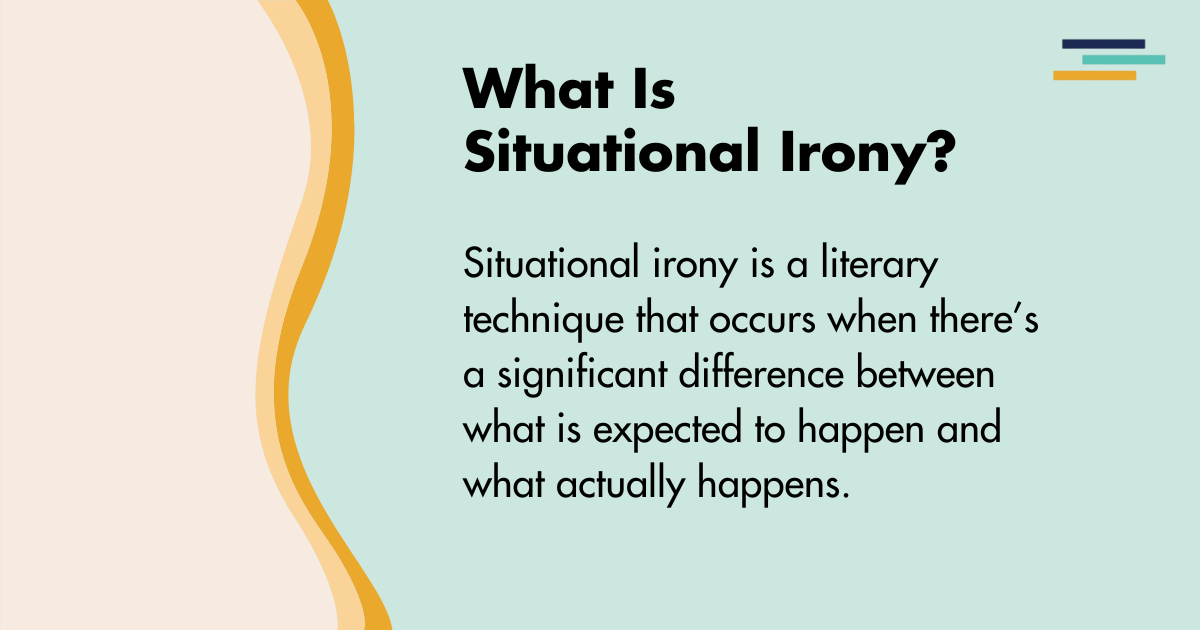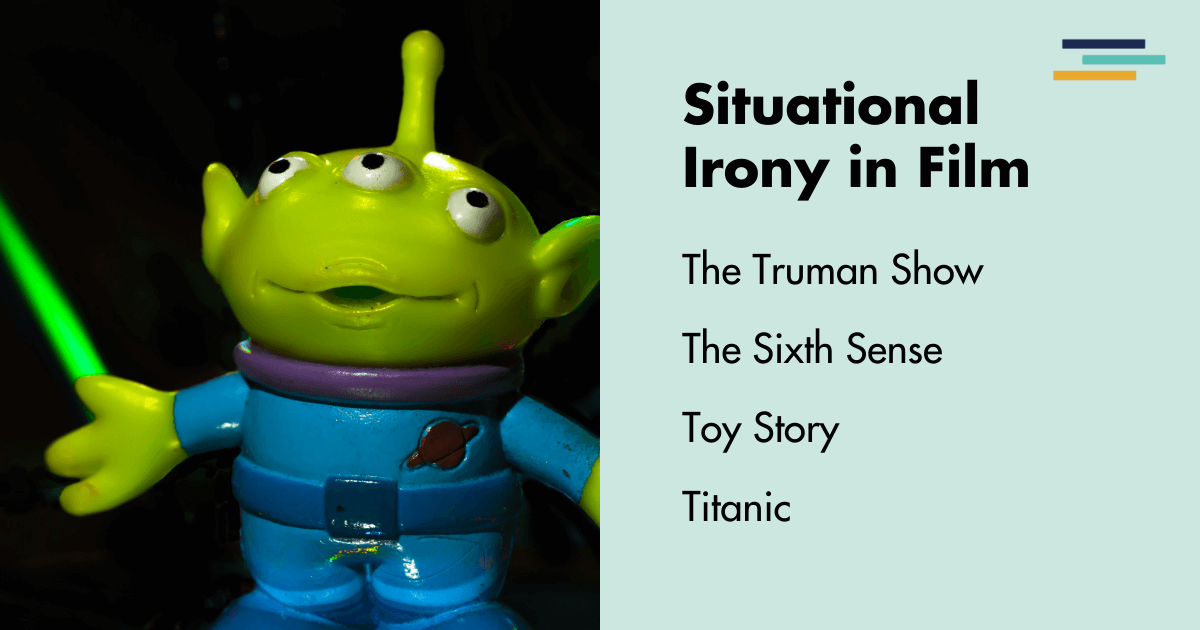
Situational irony is one of the most engaging and unexpected storytelling tools you can use.
It occurs when there’s a stark contrast between what is expected to happen and what actually happens.
This ironic twist not only grabs your audience’s attention but also adds depth to your characters and plot. When used effectively, situational irony can inject humor, suspense, or even tragedy into a story.
In this article, you’ll explore what situational irony is, how you can write it, and how it’s used in both literature and film to create memorable and impactful moments.
What Is Situational Irony?
Situational irony is all about surprise. It hinges on the gap between expectation and reality.
Readers or characters expect one outcome, only to be blindsided by something completely different. This technique works beautifully in all genres, from comedy to drama, because it plays with the audience’s assumptions, making them rethink the narrative.
Situational Irony Definition
Situational irony occurs when there’s a significant difference between what is expected to happen and what actually happens.
Unlike dramatic irony, where the audience knows something the characters don’t, situational irony surprises both the characters and the audience. The twist creates a moment of unexpected realization, often causing the audience to rethink the events that led to it.

Situational Irony Meaning
The meaning of situational irony goes beyond a simple twist. It reflects the unpredictability of life, showing that plans and expectations rarely align with reality.
In stories, situational irony can serve various purposes. It can:
- Add humor
- Add tragedy, or
- Highlight the futility of certain actions
It reminds us that outcomes aren’t always in our control, no matter how much we prepare.
Tips For Writing Situational Irony
Writing situational irony can be tricky, but when done right, it can elevate your story. Here are some tips to help you effectively weave situational irony into your narrative.
1. Set Clear Expectations Early
For situational irony to have its full effect, you need to set up clear expectations at the beginning.
Make sure both your characters and readers expect a certain outcome. Then, when the opposite happens, the contrast becomes striking. The key is to make the expected outcome believable and logical, so the twist feels surprising, but not out of place.
2. Add a Layer of Subtext
Situational irony works best when there’s more going on beneath the surface. Layer in subtext or hidden meaning that hints at the true outcome without giving it away.
This not only builds tension, but also creates a richer, more complex narrative. Readers should feel that, in hindsight, the ironic twist makes perfect sense, even if they didn’t see it coming.
3. Don’t Force It
Irony should feel organic to the story. If it feels too contrived, it can fall flat and lose its impact.
Avoid trying to shoehorn an ironic twist just for the sake of it. Instead, let the story naturally develop in a way that leads to a surprising, yet believable, outcome.
4. Use Irony to Enhance Theme
Situational irony often underscores larger themes in your story.
For example, if your story deals with fate, control, or hubris, irony can serve as a powerful tool to highlight these ideas. The unexpected twist can reinforce the message you’re trying to convey, adding depth to the story’s overall meaning.
5. Make It Emotional
Irony can pack an emotional punch if used correctly.
Whether it’s humor, sadness, or shock, make sure the twist evokes a strong emotional response from your audience. When an author shatters a character’s expectations, it should hit the reader hard, making the moment unforgettable.
6. Balance Irony with Pacing
Situational irony requires careful pacing.
The buildup to the twist should be slow enough to create suspense, but not so drawn out that the audience loses interest. On the flip side, the reveal should happen at just the right moment for maximum impact. Too soon, and it won’t land. Too late, and it might feel underwhelming.
Striking the right balance is key to making situational irony work.

7. Give Your Characters Agency
Situational irony often works best when it’s driven by character decisions. Let your characters act with obvious intentions and allow their choices to lead them toward an ironic fate.
This not only deepens the irony but also makes it feel more personal, as the characters’ actions directly contribute to the unexpected outcome.
8. Keep Your Characters’ Motivations Clear
For situational irony to work, it’s essential that your characters’ motivations are clear and understandable.
The irony hits harder when readers fully understand why a character expects a certain outcome. By making their desires and motivations explicit, you set the stage for a powerful contrast when things don’t go as planned.
This clarity adds depth to the irony and makes the twist feel more meaningful.
9. Contrast Expectations with Consequences
Situational irony is most impactful when the consequences of an action are opposed to what we expect.
To amplify this, build a strong contrast between the character’s intention and the actual outcome.
For example, if a character takes extreme precautions to avoid disaster, only for their actions to cause the very catastrophe they were trying to prevent, the irony becomes even more pronounced.
Use this contrast to highlight the unpredictability of life and fate.
10. Use Foreshadowing to Build Suspense
While the twist in situational irony should surprise both the characters and readers, you can still use subtle foreshadowing to build suspense without giving away the twist.
Drop small, inconspicuous clues that, in hindsight, make the irony feel inevitable.
This not only adds layers to your story but also makes the twist more satisfying, as readers will feel rewarded when they recognize the signs leading to the ironic outcome.
Examples of Situational Irony in Literature
Countless authors have used situational irony to create memorable and thought-provoking moments.
Let’s look at some classic examples in literature.
O. Henry’s The Gift of the Magi
In O. Henry’s short story, The Gift of the Magi, a young couple sacrifices their most prized possessions to buy each other Christmas gifts. The wife sells her long hair to buy a chain for her husband’s watch, while the husband sells his watch to buy combs for his wife’s hair.
The situational irony lies in the fact that their gifts are now useless, as both have given up the very items the gifts were meant for. The twist highlights the theme of selfless love, even though their actions render the gifts impractical.
George Orwell’s Animal Farm
In George Orwell’s Animal Farm, the animals overthrow their human oppressors hoping to create an equal society. However, as the story progresses, the pigs who lead the revolution become as corrupt and tyrannical as the humans they replaced.
The situational irony is brilliant because the animals’ rebellion leads them to the very oppression they sought to escape, highlighting the cyclical nature of power and corruption.
William Shakespeare’s Romeo and Juliet
One of the most famous examples of situational irony occurs in Shakespeare’s Romeo and Juliet.
At the climax of the play, Juliet takes a potion to fake her death, hoping to be reunited with Romeo. However, Romeo believes she has truly died and takes his own life. Moments later, Juliet awakens to find him dead and then kills herself.
This tragic irony works because both characters’ attempts to be together lead to their ultimate separation in death.
Edith Wharton’s Ethan Frome
In Edith Wharton’s Ethan Frome, the titular character and his love interest, Mattie, attempt to escape their grim lives by sledding into a tree, hoping for a quick death. However, they both survive, but Mattie is paralyzed, and Ethan is crippled.
The situational irony here is that their attempt to escape their miserable lives only traps them in a worse situation, both bound in suffering.
Examples of Situational Irony in Film

Situational irony is also a powerful tool in film, often used to create memorable plot twists that leave audiences reeling.
Here are some standout examples:
The Truman Show
In The Truman Show, Truman Burbank believes he’s living a normal life, unaware that his entire world is a constructed television set and everyone around him is an actor.
The situational irony occurs when Truman finally discovers the truth…
That his whole life gets manipulated for entertainment.
The audience, who initially feels superior in their knowledge of the setup, has to reflect on the ethics of manipulating Truman’s life for amusement.
The Sixth Sense
In The Sixth Sense, situational irony plays a pivotal role in the film’s shocking twist.
Throughout the movie, Dr. Malcolm Crowe is helping a young boy who claims to see dead people. The audience discovers the situational irony at the end when Crowe realizes that he himself has been dead the entire time.
This revelation catches the audience, along with Crowe, off-guard, transforming the way they interpret everything that came before it.
Toy Story
In Toy Story, the toys live with the fear of being replaced by newer, better toys.
Woody, the favorite toy, becomes jealous of Buzz Lightyear, the shiny new space toy. The situational irony occurs when Buzz, who truly believes he is a space ranger, eventually discovers he is just a toy.
The twist is not just humorous but also serves to develop Buzz’s character as he comes to terms with his true identity.
Titanic
In Titanic, someone famously describes the ship as “unsinkable,” which sets up the central situational irony of the film.
The passengers and crew are confident in the ship’s invincibility, yet it famously sinks after hitting an iceberg. The irony underscores themes of human hubris and the unpredictability of fate, making the tragedy even more poignant.
By using situational irony in your writing, you can craft powerful, memorable moments that resonate with readers on a deeper level.
It’s an excellent way to subvert expectations, add complexity to your plot, and keep your audience guessing. Whether you’re writing comedy or tragedy, situational irony is a tool worth mastering.
And finally, always remember that the story comes first. Focus on:
- Creating engaging characters
- Penning interesting plots
- Structuring solid settings
A tool like Fictionary helps you turn your draft into an interesting story readers love. So, with a strong narrative foundation, your writing can truly shine.


